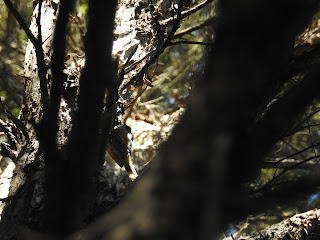Today was mainly to be a day of relaxing, however we had booked a Patterson Inlet wildlife cruise (again with Furhana of Ruggedy Ranges) as the weather was too calm for a pelagic to be productive. We first approached a group of
red-billed gulls, kelp gulls and
white-fronted terns hovering over the water, feeding on fish. Close inspection revealed some distant
spotted shags, as well as several rafts of
little blue penguins.
This little blue penguin was one of many we saw on the cruise
We then headed out to sea, past a lighthouse and towards Sarah's Cove. On the way, our skipper, Kevin, spotted a distant
white-capped albatross. Using some fish Furhana had brought to attract birds, we managed to lure it near our boat. A second, juvenile
white-capped albatross soon appeared and both birds gave us spectacular views.
The white-capped albatross is one of 3 species recently split from the shy albratross
You can tell this bird is an adult because its bill has a bright yellow tip
Though small for an albatross, white-capped albatrosses still have large wingspans
We then entered Sarah's Cove and watched for Fiordland crested penguins, though none were seen. On the way to the next site, a lifer
Buller's albatross flew past the boat. The fish came in handy again, as we were able to lure it near the boat. The
white-capped albatrosses from the previous feeding realised what was going on and also flew in.
A Buller's albatross flies past the Stewart Island coastline
The yellow-black bill and grey head show this bird is a Buller's albatross
The white-capped (left) and Buller's albatrosses (right) swimming together
Our next stop was a large rocky islet protruding from the sea and alive with birds. Two endemic
spotted shags perched on one side of the rock, while a stunning
Stewart Island shag scanned the sea from the top.
White-fronted terns, kelp gulls and
red-billed gulls were all perched atop the right-hand side of the rock. Finally, a white-throated phase
little pied cormorant was drying its wings on the far end.
The spotted shag on the right's crest shows it has entered breeding phase
Though also found in Australia, the stronghold of the white-fronted tern is New Zealand
The white-throated form of the little pied cormorant is unique to New Zealand
The Stewart Island shag has two forms: the pied form (shown here) and a bronze form
Our second-last stop was the Snuggery, an area of Ulva Island where
pied cormorants, little black cormorants and
little pied cormorants breed. The area was alive with activity. Many of the large cormorant nests still held a chick. We even got to see some parents feeding their young by regurgitating into their throats.
The pied cormorant is another bird commoner in Australia than New Zealand
We cruised by the Bravo Islands looking for yellow-eyed penguin, but were not successful. We then returned to the island, where we relaxed for the rest of the day. The only event of note bird-wise was near dinner, when I observed a
kelp gull trying to eat a sea star it had caught.
The kelp gull is abundant in New Zealand, but quite uncommon in Australia




















































